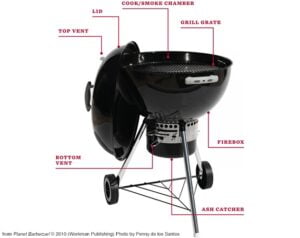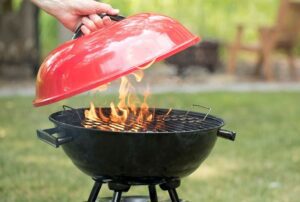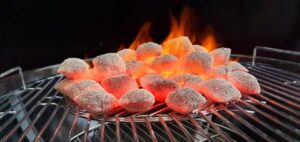What is a Barbecue Charcoal Grill?
- A charcoal barbecue grill is a cooking device that uses charcoal as its primary fuel source to generate heat for grilling food.
- It typically consists of a metal or ceramic body with a cooking grate positioned above the charcoal bed.
- Here’s a brief overview of its main components and how it works:

Barbecue Charcoal Grill
- Body:
- The main structure of the grill is often made of metal, such as stainless steel or cast iron, or ceramic materials.
- This body encloses the charcoal and provides support for the cooking grate.
- Charcoal Grate:
- Located at the bottom of the grill, this grate holds the charcoal in place and allows air to circulate underneath, promoting combustion.
- Cooking Grate:
- Positioned above the charcoal bed, this is where you place the food for grilling.
- It often has openings or grates to allow the heat and smoke from the charcoal to reach the food.
- Ventilation:
- Charcoal grills typically have vents or dampers that can be adjusted to control the airflow.
- Managing the vents helps regulate the temperature inside the grill.
- More air usually means a hotter fire, while less air can lower the temperature.
- Lid:
- Many charcoal grills come with a lid, which can be opened or closed during cooking.
- The lid helps trap heat and smoke, enhancing the flavor of the food.
- It’s especially useful for indirect grilling and smoking.

How to use a charcoal barbecue grill:
- Charcoal grills are popular for imparting a distinct smoky flavor to the food, and many enthusiasts appreciate the traditional grilling experience they provide.
- However, they require more hands-on management of the fire compared to other types of grills, such as gas grills.
- Using a charcoal barbecue grill involves several steps, from preparing the charcoal to cooking your food. Here’s a step-by-step guide to help you use a charcoal grill effectively:
Gather Supplies:
- Charcoal (briquettes or lump charcoal)
- Chimney starter or lighter fluid
- Firestarter cubes or newspaper
- Long-handled tongs
- Grill brush for cleaning
- Cooking oil or non-stick cooking spray
- Meat or vegetables to grill
Choose the Right Charcoal:
- Decide between briquettes and lump charcoal based on your preferences and cooking style.
3. Prepare the Grill:
- Set up your charcoal grill in a well-ventilated outdoor area away from flammable objects.
- Ensure all vents are open before lighting to allow proper airflow.
4. Light the Charcoal:
- Chimney Starter Method:
- Fill the chimney starter with charcoal.
- Place a firestarter cube or crumpled newspaper underneath and light it.
- Once the charcoal is ashed over (white-grayish appearance), carefully pour it onto the charcoal grate.
- Lighter Fluid Method:
- Arrange the charcoal in a pyramid shape on the charcoal grate.
- Add lighter fluid evenly to the charcoal.
- Wait a few minutes for the fluid to soak in, then light the charcoal.
5. Wait for the Charcoal to Heat:
- Allow the charcoal to burn until it’s covered with a layer of ash. This indicates that it’s ready for cooking.
6. Spread the Charcoal:
- Use long-handled tongs to spread the hot charcoal evenly across the charcoal grate.
7. Adjust Vents:
- Adjust the vents on the bottom and top of the grill to control airflow and temperature. Open vents for higher heat, and close them for lower heat.
8. Preheat the Grill:
- Close the lid and let the grill preheat for 10-15 minutes.
9. Oil the Grates:
- Dip a folded paper towel in cooking oil and use tongs to oil the grates to prevent sticking.
10. Cooking:
- Place your food on the preheated grates.
- Monitor and flip the food as needed.
- Use a meat thermometer to ensure proper doneness.
11. Extinguish the Charcoal:
- To extinguish the charcoal after cooking, close the vents to cut off the oxygen supply.
- Save any unused charcoal for future grilling sessions.
12. Clean the Grill:
- Once the grill has cooled, use a grill brush to clean the grates.
13. Store the Grill:
- If your grill has a lid, cover it to protect it from the elements.
Remember to follow safety precautions, such as using heat-resistant gloves and keeping a safe distance from the hot grill. Additionally, always follow the manufacturer’s instructions for your specific charcoal grill model. With practice, you’ll become more comfortable and skilled at using a charcoal barbecue grill
Benefits of a Charcoal Barbecue Grill
- The importance of a charcoal barbecue grill lies in several aspects, making it a popular choice among grilling enthusiasts.
- Here are some reasons why people appreciate and choose charcoal barbecue grills:
Flavor Enhancement:
- One of the key advantages of charcoal grilling is the distinct smoky flavor it imparts to the food.
- The charcoal combustion process releases compounds that enhance the taste and aroma of grilled items, providing a unique and authentic barbecue flavor.
Versatility
- Charcoal grills offer versatility in cooking styles.
- Whether you’re grilling steaks, burgers, poultry, fish, or vegetables, a charcoal grill allows for different techniques, including direct grilling for searing and indirect grilling for slow cooking and smoking.
High Temperature Capability:
- Charcoal grills can reach higher temperatures than some other types of grills.
- This is beneficial for achieving a perfect sear on steaks and burgers, creating a crispy crust on meats, and quickly cooking thinner cuts of meat.

Traditional Grilling Experience:
- Many people appreciate the traditional and hands-on experience of using a charcoal grill. Building and managing the fire, adjusting vents to control temperature
- The overall process of charcoal grilling can be enjoyable for those who appreciate the ritual of outdoor cooking.
Portability
- Charcoal grills are often more portable than larger gas grills, making them suitable for picnics, camping trips, and tailgating events. They don’t rely on a gas connection, allowing users to grill in various outdoor settings.
Lower Initial Cost:
- In general, charcoal grills tend to be more affordable than some high-end gas grills.
- This can be appealing to individuals who want a reliable and effective grilling option without a significant upfront investment.
Minimal Maintenance:
- Charcoal grills are relatively simple in design, with fewer components than some gas grills. This simplicity often translates to easier maintenance and fewer parts to clean or replace.
Cultural and Social Significance:
- Charcoal grilling is deeply ingrained in the culture of barbecue enthusiasts around the world. For many, the act of grilling with charcoal is a social and cultural experience, with gatherings centered around the barbecue, fostering a sense of community and tradition.
- While charcoal grills have their advantages, it’s important to note that they also require some skill and attention to achieve the desired results.
Types of Charcoal Grills
- There are several types of barbecue charcoal grills available on the market, each catering to different preferences and needs.
- When choosing a barbecue charcoal grill, consider factors such as size, material, additional features, and your preferred cooking style.
- Each type has its unique characteristics and advantages, catering to different grilling preferences.
- Here are some common types:
Which Coal is the Best for Charcoal Grills
- Managing the fire, controlling temperature, and mastering indirect grilling techniques can take some practice.
- The choice between less smoke charcoal and other types of grills ultimately depends on personal preferences, cooking styles, and the overall grilling experience one seeks
- When choosing charcoal for charcoal grills, there are two main types to consider
- briquettes and lump charcoal.
- Each has its characteristics, and the “best” option depends on your preferences, cooking style, and specific needs.
- Here’s a comparison of both types:

Charcoal Briquettes:
-
- Composition: Briquettes are made from compressed charcoal dust and other additives like binders, fillers, and sometimes even lighting agents.
- Consistency: They provide a consistent and steady burn due to their uniform shape and composition.
- Burn Time: Briquettes generally have a longer burn time than lump charcoal, making them suitable for longer cooking sessions.
- Cost: Briquettes are often more affordable than lump charcoal.
- Availability: They are widely available in grocery stores and supermarkets.

Lump Charcoal:
-
- Composition: Lump charcoal is made from natural hardwood, with no additives. It consists of irregularly shaped pieces of wood that have been carbonized.
- Flavor: Many grilling enthusiasts prefer lump charcoal for its ability to impart a more authentic and natural smoky flavor to the food.
- Temperature: Lump charcoal tends to reach higher temperatures more quickly than briquettes, making it suitable for high-heat grilling.
- Ash Production: Lump charcoal generally produces less ash compared to briquettes.
- Versatility: Lump charcoal is versatile and can be used for both direct and indirect grilling, as well as smoking.
- Lighting Time: It may require more attention when lighting compared to briquettes.
Choosing the Best Charcoal:
- Cooking Style: If you often do long, slow cooks or smoke meats, briquettes might be a good choice for their longer burn time. If you prefer high-heat grilling or want a more natural smoky flavor, lump charcoal may be better.
- Flavor Preference: If the smoky flavor is a priority, many grilling enthusiasts prefer lump charcoal due to its minimal processing and additives.
- Convenience: Briquettes are generally more consistent and easier to light, making them a convenient choice, especially for beginners. Lump charcoal may require more attention during lighting and cooking.
- Cost: Briquettes are usually more budget-friendly, so if cost is a significant factor, they might be the better option.
- Availability: If convenience and accessibility are essential, briquettes are widely available in most stores.



